

|
Home Updates Hydros Cars Engines Contacts Links Contact On The Wire ←Previous Page 1 2 3 4 |
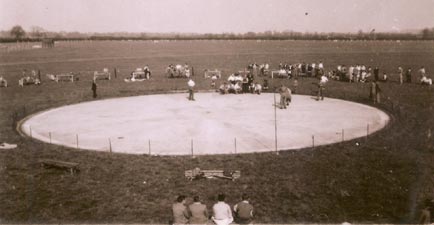
With activities at the Sportsdrome expanding, the future for this venture looked encouraging but Eaton Bray and DAR were to experience a severe setback in October 1947 when they were taken to task for some of the ‘unorthodox activities’ that DAR had referred to earlier. Both the company and Russell were served with summonses for carrying out building work and constructing a drive at the aerodrome between 1st July 1946 and January 31st 1947, and for carrying out building work without a licence, contrary to the Defence Regulations. The case lasted through to January 1948 and resulted in the Sportsdrome and DAR being found guilty. DAR was fined £1,500 for carrying out £11,884 worth of building work and constructing the drive. The company was also fined £3,000 for these offences. The fines totalled £4,500 (£180,000 in today’s terms) and costs of £68 were also awarded against them. The court gave 28 days to pay, with non-payment resulting in six months imprisonment. The annual statement for 1946/47 had shown a trade profit of £3,000 but there was no cash in hand or in the bank and no working capital apparently available at that time. To find that sum must have called for all DAR’s powers of persuasion with numerous letters being sent to the court pointing out the parlous financial state that DAR and the Sportsdrome were in and requesting further time to pay the fines. Michael Russell, Douglas’s son, thought that “he, DAR took a calculated gamble to build the main building before the planners brought any action against him, on the basis that, even if he lost the case at least he had the building which he knew in those days would not have to be taken down.”
The court case and fine was not the only financial problem that DAR was experiencing at this time. He led something of a lavish lifestyle even if it was not always sustainable. This, coupled with the post-war depression and era of austerity, was to have serious implications for him. Most significantly the Aeromodeller had also run into debt. As a result DAR sold MAP, which of course included the ‘Aeromodeller’, to Argus Press. A condition of the sale was that DAR would be staying on as Managing Director of the magazine.
|
With the Sportsdrome also struggling financially another company was created as a form of diversification to create jobs for some of the staff. In the winter of 1947 the name Model Accessories Supply Co (MASCO) appeared. Geoffrey Deason’s design of a model racecar was one of its early products. The MASCO ‘Kitten’ came as a kit and was built round the Mills 1.3cc diesel engine. Marketed as a ‘kitchen table special’ because it needed only the most basic tools to construct it and was aimed at beginners. Tim Russell recalls spending a fair proportion of his school holidays operating a power saw and lathe making flywheels for the ‘Kitten’. The cost for the kit was 75 shillings initially, but by 1950 was reduced to 49/6d. Easy payments were also offered, for the Kitten, a deposit of 14 shillings was required, with five monthly payments of 10 shillings, and a final payment of 11 shillings, way ahead of its time in offering interest free loans. Right: 1947 Full page colour advert for MASCO products |
|
Castings for diesel engines designed by Lawrence Sparey also appeared on the list of products. The ‘Buzzard’ 2.8cc diesel engine, for which the die-casting could be purchased for 21 shillings, appeared in the ever-expanding MASCO list. Described as a ‘new design by best-known diesel experts DAR and LH Sparey’, it too could be bought on similar easy payment terms. Previous to this an article on diesel engines by Lawrence Sparey with the foreword by DAR had appeared in Dec 45 issue of the Aeromodeller. DAR wrote, “my own experience of internal combustion engines ranges over the past 25 years. Shortly after the last war (WW1) I was engaged on the manufacture of ‘diesel’, semi diesel, ’hot-bulb’ and the normal type of petrol engines of capacities of from a few horsepower up to as much as fifty horsepower per cylinder. And in that period there have been innumerable improvements, alterations, additions, (not to mention subtractions!) attributable to many men. Who invented the model diesel engine? I can only say, I do not know, certainly we did not. But we were the first in this country to carry out over the past three or four years, considerable research and development work. This, however, does at least enable us to publish the first authoritative survey on this type of engine, based on our own practical work.”
Despite the serious financial situation surrounding DAR and the Sportsdrome this did not appear to curtail or restrict his various ventures in any way. In August 1948 DAR and C Rushbrooke the then editor of ‘Aeromodeller’ flew out on a 2-week trip to New York. The primary purpose of the trip was to attend the Wakefield Trophy contest in Akron, Ohio along with a team representing Britain. While the rest flew on to Akron, DAR was driven by car the 1,500 miles from New York by Irwin Polk, mixing business with pleasure. Once back in New York, DAR and Rushbrooke stayed a night with Ray Arden and his wife. The American experience appeared to be greatly enjoyed after the austerity conditions still prevailing in England.
|
|
Cine photography was a hobby of DAR and in 1945 he had used a 16mm Kodak with safety film to record a 28-minute film of the Dorland Hall exhibition, which could be hired for 10 shillings and sixpence a week by interested clubs. DAR filmed in colour the previous years Wakefield in England, the American trip and in 1950 the competition held in Jamijarvi, Finland. Once again they were offered for hire, along with a 1,000-watt auditorium type projector for projecting the films, although no price was given this time. Left: Joan and DAR, cine-camera at the ready, in Jamijarvi, Finland |
As a contrast to the situation in the US, Britain was in dire trouble, which had a significant impact on the modelling world, with strict regulations on what could be produced and sold, as well as the introduction of Purchase Tax. Even well into 1948 The Bedfordshire War Agricultural Committee still retained the Sportsdrome land under requisition, which meant that a herd of cows were free to graze. Negotiations with the BWAC saw more of the Sportsdrome land being released for use and in a further attempt at diversification, two grass track meetings were held, organised by Luton and District Motorcycle Club, although there was still petrol rationing at this time.
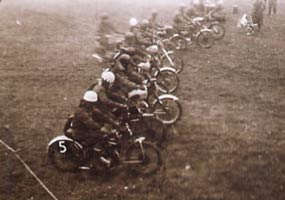 |
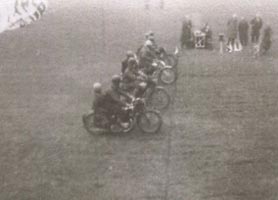 |
 |
|
The first of two 100ft ‘Nissen’ type buildings was also erected in 1948 for modeller’s holiday camp accommodation. Right: Taken in 1950 during the 4th and last International aeromodelling week |
|
|
|
By the 1949 season, Eaton Bray was hosting several major tethered car events, with trophies donated by major car manufacturers. The season started at Easter with the MG Trophy Meeting. The competition was for the best speed by a reasonably realistic and appropriately sized car, with a motor not exceeding 2.5cc. May saw the Austin Trophy that was won by W S Warne with his 10cc Dooling, at 113.21mph giving him a national record. Gerry Buck came second at 109.87 mph with ‘Topsy’ for a British record. June and the Drysdale Trophy, for a two-car team relay race, over half a mile, divided into 2.5cc, 5cc and 10cc classes. |
|
In July of that year they hosted the MCA Southern Regional Eliminating Trials and the Russell Trophy. This was for points awarded for scale and then added to the points gained for speed. The Hastings Trophy followed for teams of three, with one car in 2.5cc, 5cc and 10cc each being awarded points for ‘home construction’ and speed. September and the Jaguar Trophy was held in conjunction with the Percival Marshall Memorial Cup and the Sutton Trophy. The Jaguar was a class handicap speed event, while the other two were for the home constructor with points being awarded for workmanship and speed. The Sutton was for cars not exceeding 5cc. Right: The Russell family watching Harold Pratley judging the concours section of the Russell Trophy |
|
Jack Morgan wrote in the Retro Club newsletter about a typical car meeting at Eaton Bray. “Arrival was on Friday night and we would stay in the Swan Hotel in Leighton Buzzard, and take over the whole place, high jinks and what not. Saturday we would go up to the track for practice, come back to the hotel at night. Race on the Sunday, then all go home, just like the full size people. The motor trade started to give us trophies, Jaguar, Lucas, KLG, etc. Some quite famous people came to see us race, Goldie Gardener came and stopped at our ‘pit’, Gascoigne and myself had built a model of his MG Midget, which he had set many records with and so I asked him if he would autograph it for us. As he did not have a pen to hand he scratched his name on the inside of the body. It is still there to this day.”
Whit Monday 1949 and Eaton Bray staged its first air display. Advertising for the event, included words like ‘barnstorming’ and ‘joyriding’. For the grand sum of 10 shillings each, people could take a pleasure flight in a Fairchild Argus Monoplane flown by Joan Nayler.
|
Joan was a highly experienced pilot having been a 1st Officer in the Air Transport Auxiliary (ATA) during the war ferrying a wide range of aircraft, including Spitfires. Flying her Puss Moth, Joan ran a charter service from White Waltham under the title ‘Naylor Air Services’. In 1950 she was to become the next Mrs Russell following DAR’s acrimonious divorce from Grace. Joan in Spitfire on left and with Puss Moth on right |
|
|
Wreford Fisher has provided his memories of other pleasure flights from Eaton Bray. "The Miles Messenger that did the pleasure flying was from the Dunstable Flying Club - London and Cambridge - the pilot was a woman, who I paid my five shillings to her for the first flight of my life which started off a lifetime of commercial flying and instructing. I owe a lot to Eaton Bray and DAR."
Another service in 1949 was the ‘Aeromodeller public address vehicle’ being offered for hire. It was a type of station wagon with a pair of loudspeakers mounted on the roof and inside a set of amplifiers and other equipment. The idea was that it would be hired out to model flying clubs when they ran large meetings or rallies.
|
An even more remarkable venture also started around 1949, and this was to build a ‘mini’ car to take advantage of a cheap road fund licence for very light cars or three wheelers. The car was named the Russon, and here I have heard two versions as to how the name came into being. One is that it was from the first three letters of Russell and then son was added, but the one I think is more likely is that it was a collaboration between Geoffrey Deason and DAR hence Rus/son. |
|
Deason soon pulled out of the venture, but DAR’s son Michael had recently returned from National Service and was integrated into the company thus providing a convenient alternative basis for the name! Russon Cars Ltd, as it became known, had its workshop in one of the Nissen huts, although photographs show manufacturing taking place in part of the E block. Staff from the publishing side often found themselves drafted into car production to augment the four actual staff members.
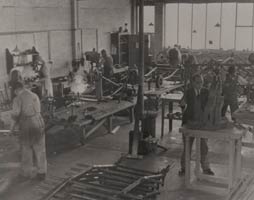 |
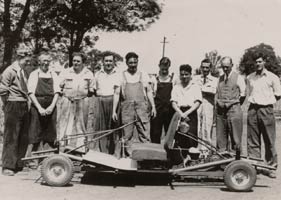 |
 |
Wreford Fisher further recalls the Russon having a 197cc Villiers engine. He goes on to mention that " One of them had fitted a 249cc twin Excelsior motorcycle engine - (still no reverse) with the rear passenger seated crosswise."
|
|
The first prototype was registered in 1950 at the Bedfordshire Council licensing office and bore the number HMJ 263. The production version showed considerable changes, especially to the body. At £423 15s 0d it was overpriced for its market and only about eight were sold altogether. The project was like several of DAR’s other ventures, under financed and with his costing grossly under estimated. As can be seen from the brochure above, the body on the production model was much more shapely and sleek than the prototype version shown on the left. |
In 1949 the following paragraph appeared in the August edition of Aeromodeller “On account of the wider range of ‘activities’ now being organised at Eaton Bray the word ‘model’ will shortly be dropped from the name of the company, which will become known as Eaton Bray Sportsdrome Ltd.”
Expanding the concept of a ‘Sportsdrome’ even further, horsepower of a more traditional nature was introduced in 1950 with horse racing. The first meeting took place on Easter Monday 10th April, and was described as a ‘flapping meeting’, which essentially means that they were unlicensed and that any horse and rider could compete. Other equestrian events followed with gymkhanas, show jumping, horse and pony racing, along with American style trotting in sulkies, adding to the ever-varying list of activities.
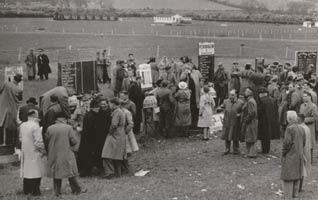 |
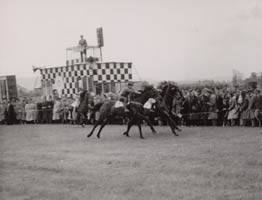 |
 |
It was becoming obvious that the core concept of the ‘Sportsdrome’ as a modelling venue was under threat. The mass popularity of tethered car racing was beginning to wane and numerous other purpose built tracks had appeared all round the country making the regular journey to Eaton Bray less necessary. Rail racing was becoming ever more popular and although a track was proposed at the site, it never materialised. ‘Model Cars’ ceased publication in the autumn of 1950 giving way to the ‘Model Maker’, which was of more general interest. Inevitably demand for plans, publications and products from MASCO were greatly reduced leaving only the aeromodelling, with its increased awareness of radio control, to support the business.
The wire fences and grazing cattle that had been a constant bone of contention were finally removed in 1951 when the land that had been requisitioned by the Bedfordshire War Agricultural Executive Committee was finally released. In the belief that there was to be a resurgence of interest in aeromodelling, the non-modelling activities such as the grass track events and horse racing were also abandoned that year.
|
|
1951 would appear to bring to an end tethered car racing as well with a combined event on 23rd September. The Russell, Jaguar and Sutton Trophies were run on the same day with relatively small numbers of competitors. Arthur Weaver won the Russell with his ERA, Alec Snelling the Jaguar with a Dooling and C W Field the Sutton with an Alfa Romeo. Left: Aerial shot for the Eaton Bray Gazette vol. 3 No 2 1948 |
There was no doubt that the Sportsdrome was in decline as were, DAR’s many and varied companies and business interests. Those who worked at Eaton Bray at the time have remarked upon the parlous financial state that existed, recalling that he was constantly juggling what income there was to keep the entire operation afloat. DAR was fighting a losing battle and when in March 1952 Argus Press decided to relocate the publishing business to Clarendon Road, Watford almost overnight, it left the airfield without a tenant or any income. Argus had moved without DAR’s knowledge and effectively removed him entirely from their operation. The whole ‘Sportsdrome’ enterprise and everything connected to it crumbled and was placed in receivership. Although a separate company the Russon operation was also in trouble and was sold, along with its assets, to the legendary Air Vice Marshall DCT Bennett, founder of the Pathfinder’s during the 2nd WW. Russon flourished under Bennett’s control, but under the much more familiar name of Fairthorpe Ltd.
The Russell family fortunes by now were close to zero and everything was sold including the family home, ‘Shothanger Wood Cottage’, which had also suffered a fire that had destroyed the thatch. Douglas and Joan with their two young children Edwin and Sheena moved to Batchelor Cottage, on the Harleyford Estate at Marlow in Buckinghamshire.
|
|
|
Around 1954/55 the family moved again, this time to Norton Way South in Letchworth. Showing the same entrepreneurial spirit that had led to the establishment of Eaton Bray originally, Russell now into his fifties started again. Under the imprint of Harleyford Publications he was to produce and market many thousands of copies of some sixteen titles on aviation history. Far left: DAR with son Michael about to fly a consignment of Harleyford books to Jersey |
During the course of this venture he relocated the family to California following up a business interest there. The house at Letchworth was closed up, while leaving the staff in the adjoining offices that he had built. Despite designing and building a new house in California, changing circumstances in the UK required him to move back to Letchworth within a couple of years. Harleyford continued for many years until it closed finally in 1971. DAR was by then 68 and in poor health, and suffering from arthritis in the hips, which caused severe pain and mobility problems.
|
His last public appearance was on Wednesday November 22nd 1972 when, barely able to walk, he was presented with a Certificate by HRH The Duke of Edinburgh, commemorating 50 years of the Society of Model Aeronautical Engineers. It was also special in that there where the four editors of the Aeromodeller present, covering 36 years from 1936 to 1972. From left: Peter Richardson, Ron Moulton, Harry Hundleby, and Douglas Russell, |
|
|
In March, Douglas Russell suffered a stroke and died on the 9th April 1973 at the age of 70, his eldest son Michael wrote the following in memory of his father: -
“It would be unkind to judge him only by his failures, for they were largely financial, better to remember what he achieved, and what, like Aeromodeller, the Harleyford Series, Aircraft of the Fighting Powers, a whole shelf of Model Aircraft Books. The years with BI Cables, Stewarts and Lloyd’s and London Electric Wire Co. North London Bookbinding, Model Maker, Model Car, Air Review and all the successful model aircraft and Dorland Hall Exhibitions. Eaton Bray Model Sportsdrome, the air displays, the horse races, his SS100 model, riding his Sunbeam S8 in the 1950’s, Householder Magazine and very many other ventures, always in parallel, and sometimes overlapping.”
Many of the people that worked for DAR on aeromodelling aspects have written extensively about their experiences, yet I found few people who remembered or were involved with tethered car racing at Eaton Bray. What started as a relatively simple task has grown enormously and contact with members of the Russell family has given me a far greater understanding of the person who had a major impact on the modelling world and created a facility that is still so sadly lacking in Britain today
From all that has been written and said by those who knew and worked in the various companies under DAR’s control it would be fair to say that relationships were not always cordial yet he seemed to engender a remarkable level of loyalty amongst his staff. The financial problems that he suffered and the methods to which he resorted in order to keep the ‘Sportsdrome’ functioning were also common knowledge at the time. There is no doubt that many investors lost a great deal of money through the businesses, yet whatever his critics might say, it had taken a bold step and a great deal of determination to bring the Sportsdrome into being in that period of British history. The books and magazines that he produced are still sought after and carry a commensurate price, often between 50 and 100 times their original value. This and the fact that nearly 60 years later, people still seek out and celebrate the place where Eaton Bray Sportsdrome stood, means that the name of Douglas Arthur Russell is unlikely to be forgotten.
What became of Eaton Bray?
The London Gazette carried the winding up notice for Eaton Bray Sportsdrome in November 1953 but it was not until April 1955 that the company finally ceased to exist.
Keith Bragg did some research in 2004 to find out what had become of the site and found that the land on which the Sportsdrome was sited had become part of Mead Farm again as it had been in 1939.
“All the buildings had gone, having been replaced by an industrial estate. The car race circle and concrete blocks that had ringed the site were all dug up at various times. The Nissen huts, positioned between the main buildings and the bottom gate had been taken down about 15 years ago. The hedges are still there and one marks the boundary between two farms. The map that was supplied by the Sportsdrome in 1945 has changed somewhat in recent times. The Leighton Buzzard bypass (A505) now sits on top of the old Leighton Buzzard to Dunstable railway line and the roads where they cross the bypass have changed shape. All the lanes around the Sportsdrome are still there. The gateway is still there and the small turning on the left hand side is the entry to Mead Farm. There is now a fence/hedge behind the industrial estate but the main part of the field is still to be seen. It is lovely and flat, now used for arable farming. Trees now line the road on both sides.”

Panoramic view of the site in 2006. Dunstable Downs in background
Putting this article together has been a very long project and inevitably, just when I thought that I had reached the end, another piece of information would appear. I am extremely grateful to the many people have contributed material and reminiscences to add to my research. I would like to thank each one of you who took the time to search out additional information and answer my questions with such patience. I am particularly grateful to those who sent printed material, photographs and other items of interest that I would have been unable to access otherwise.
Tony Marshall, Keith Miller, Graham Skillen, Peter Hill, Keith Bragg, George Cull, The late Bob Palmer, Richard Riding, Dave Welch, David Temple, Dan Bateman, Lawrence Lammens, Don Sim, Colin Brown, Dick Roberts, and Neil Harvey.
Bedfordshire and Luton Archives and Records Service, Leighton Buzzard Observer, SAM 35
The late Ron Moulton who was editor of ‘Aeromodeller’ for so many years had been unstinting in answering my numerous questions and allowing me to quote from his articles.
Whatever I had accomplished through my own research though was put into perspective by the assistance I have received from the Russell family: - the late Michael Russell, and Edwin for information and photographs, Tim for his extensive recollections, editing and corrections. Most of all to Shirley Russell, my heartfelt thanks for her encouragement, support, kindness and unrestricted access to her vast family archive.
Pathe video clip of Eaton Bray
Update:- Richard Riding reminisces about flying activities at Eaton Bray →
©copyrightOTW2010